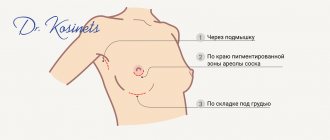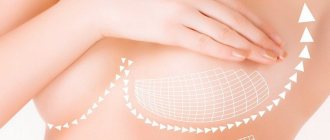In recent years, complex plastic surgeries performed after childbirth have become incredibly popular. Abroad, they are called “Mommy Makeover” and are gradually beginning to gain recognition among Russian young mothers.
What are the benefits of such an approach? The fact is that returning a lost shape with immediate restoration of health really promises a woman many advantages:
• complex operations are much cheaper than each procedure separately; • the patient undergoes one rehabilitation period, and not three or four; • a woman is transformed at once, in a few months, and not years, as with separate plastic surgeries; • the risk of complications is reduced, since anesthesia is administered once rather than 3-4 times.
In addition, after a comprehensive recovery, the young mother has the opportunity to focus entirely on raising her baby, without thinking about the need for further operations. And she is guaranteed attention from her husband, since she immediately gets back all her beauty, and in some cases, even more.
Types of plastic surgery after childbirth
Pregnancy and childbirth leave a serious imprint on a woman’s body: stretch marks, age spots, swelling, weight gain, ptosis (breast drooping) and psychological worries about all this. Despite the assurances of loved ones that the figure will recover on its own after childbirth, you need to wait a very long time for this to happen. Moreover, these expectations are not always met.
Thanks to complex plastic surgery, a woman has the opportunity to immediately tighten her stomach, get rid of scars, remove stretch marks, lose weight and tidy up her breasts. Experts recommend doing plastic surgery after 3-6 months, counting from the moment of birth. And if a young mother is breastfeeding, then only after the end of the lactation period.
Features of correction after childbirth
The postpartum period often becomes the cause of problems - breasts that are full during pregnancy subside and lose their elasticity. It becomes soft and stretch marks appear on the skin. Breasts may lose 2-3 “prenatal” sizes. Therefore, correction is especially popular among mothers.
On this topic
- Mammoplasty
Repeated mammoplasty
- Editorial board of Plasticology.ru
- October 18, 2020
There are several recommendations that help consolidate the effect of the operation for a long time:
- Mastopexy does not affect the lactation process, but it is best done after breastfeeding to avoid sagging.
- The operation should be performed only after breastfeeding has completely ended and the ducts have subsided. Otherwise, the cosmetic effect of mammopexy may disappear after breastfeeding ends.
Breast lift
This procedure is called mastopexy. It helps get rid of sagging breasts due to breastfeeding and loss of tissue elasticity. It also allows you to change the shape of your breasts to the desired one. But if a woman is planning another pregnancy, then this procedure is not recommended for her. If desired, breast augmentation can be performed simultaneously with this operation.
The general recovery period after a breast lift takes 4 weeks. The final result can be observed after 11-12 months. By then, the seams will not be visible, and the breasts will take on a perfectly round and toned shape.
Mammoplasty after childbirth: what is it?
Mammoplasty is an operation performed on the mammary glands, with which you can change the size and shape of the breast. In order to enlarge the breast, the surgeon implants an endoprosthesis. Basically, this option of mammoplasty after childbirth is resorted to in the case of a long period of lactation, after sudden weight loss after childbirth, or as a result of breast asymmetry.
Breast reduction can be done by removing part of the breast or by suctioning out the required amount of fat under the skin.
Mammoplasty after childbirth involves a breast lift, which is used as a result of prolapse of the mammary glands after childbirth and the lactation period. During the operation, the doctor removes flaps of stretched skin and creates a new type of breast.
There are also correction procedures for nipples and areolas. This method is used when the nipples become inverted or too high after childbirth, or when the areolas become enlarged.
Stretch Mark Removal
Stretch marks (or stretch marks) are one of the biggest problems of every woman who has given birth. The most problematic areas in this regard are the stomach, chest, hips, waist, and in some cases even the face. At first, stretch marks appear as lavender or pale pink streaks. However, over time they become similar to real scars. This is due to the fact that with an increase in the abdomen, internal ruptures of the connective tissue of the skin occur with damage to small vessels. But gradually they become coarser and acquire a whitish tint. You can get rid of stretch marks using several types of procedures - both cosmetic and surgical (depending on how old the stretch marks are).
Intimate plastic surgery (vaginoplasty or colporrhaphy)
All types of manipulations in intimate plastic surgery after childbirth can be divided into two groups. The first involves surgical interventions to improve the appearance of the genitals. Quite often during childbirth, an incision is made in the perineum, after which a scar remains. Sometimes it can be very rough, uneven, with “pits”. This defect is smoothed out using preparations based on hyaluronic acid.
The second group is operations designed to restore any lost function. For example, after childbirth, stretching of the perineum or vagina may occur, which leads to health problems, as well as a deterioration in the quality of intimate life. This happens especially often after the birth of a large child or repeated births. In this case, vaginal plastic surgery is necessary.
Indications:
- stretching or drooping of the anterior/posterior vaginal wall;
- episiotomy - dissection of the vaginal walls to facilitate the passage of the baby's head during childbirth or rupture of the perineum with subsequent formation of tangible scars; uterine prolapse (complete or incomplete);
- prolapse of the bladder (cystocele) and, as a result, urinary incontinence.
Contraindications: general serious diseases of the body, blood clotting disorders, inflammation of the genital organs.
What is the essence of the operation? Depending on which vaginal wall is stretched, the doctor performs anterior or posterior vaginoplasty, often combined with tightening the muscles at the anus. The essence of the operation, which lasts from an hour to an hour and a half, is that the surgeon excises an oval or diamond-shaped flap from the required vaginal wall. The flap consists only of the mucous membrane. After excision, the vaginal tissues are brought together and sutured to strengthen the muscular frame. The operation is performed under epidural or intravenous anesthesia, which is supplemented with medicated sleep.
Recovery period. Vaginoplasty is a serious operation, including because important internal organs are located near the surgical area: the bladder and rectum. It is very important to follow all the doctor's instructions, otherwise the stitches may come apart, bleeding, and you may even have to undergo a second operation. For 2 months after the operation, it is necessary to ensure “sexual rest”, limit lifting heavy objects, stress on the muscle of the anterior abdominal wall, and also exclude foods that cause constipation from the diet. It takes time for a gentle but durable scar to form on the vaginal mucosa.
Result. By reducing the volume of tissue, the entrance to the vagina is reduced, sagging and prolapse disappear, and lost tissue tone is restored. The number of nerve endings after vaginal surgery will not increase, but tactile sensitivity will increase, which makes the sensations during sex more vivid.
Advice. Kegel exercises help maintain vaginal muscle tone; they are especially effective in the first 3-6 months after childbirth.
Fat removal
It is no secret that during the period of bearing a child, a woman seriously gains weight. This is extremely necessary to provide the fetus with all the necessary substances. Typically, standard weight gain averages between 12 kg and 17 kg. Of course, after childbirth, weight drops, but often the extra pounds remain. And often forever.
To quickly remove excess fat, they resort to a procedure such as liposuction. It helps restore the contour of the chin, knees, abdomen, waist and hips. The final result of fat removal can be observed after 4-6 months.
Kinds
There are two types of breast correction: surgical and thread. The method is selected by the surgeon based on the initial data and the desired result. Incorrect selection of the method can cause a violation of the aesthetic appearance of the breast and provoke the opposite effect.
Surgical
Surgical intervention helps to tighten severely sagging breasts, helps restore shape, and helps get rid of scars. Surgical mammopexy is performed if the patient’s breasts are larger than size 2 or if ptosis is more than degree 2.
There is no need to worry about scars - the technology of the operation helps to minimize them and with some incisions they are completely invisible. During the operation, part of the skin may be excised to tighten the breast, and there is the possibility of nipple transfer. Surgery cannot completely get rid of stretch marks; it is possible to excise the area of skin with stretch marks and apply laser treatment to the rest.
On this topic
- Mammoplasty
Compression garments after mammoplasty
- Editorial board of Plasticology.ru
- October 17, 2020
For surgical mastopexy, the incision can be made in three ways:
- periareolar;
- vertical;
- T-shaped.
A periareolar incision is made around the areola of the nipple. It is effective for grade 1 ptosis on small to medium-sized breasts. Using this incision minimizes the presence of visible scars. Also used to correct the shape and size of the nipple areola.
The vertical incision is considered the most popular among plastic surgeons. It is performed around the nipple and is complemented by a skin incision from top to bottom to the chest. With this type of procedure, excess skin is excised and there is the possibility of relocating the nipple. It is used for all degrees of ptosis and is effective when performed taking into account any anatomical features.
A T-shaped incision is performed if the operation requires large-scale intervention. This type of incision makes it possible to correct prolapse in advanced stages and excise excess skin. The incision is made in the shape of an anchor: around the nipple, down from the nipple to the chest, to the sides along the inframammary fold.
Nitevoy
Less painful than surgery and has a shorter recovery period. It can be performed on those patients who are not mentally prepared for surgery. With thread correction, the result is noticeable almost immediately, but it is performed only in certain cases:
- size no more than 2;
- prevention or initial stages of ptosis;
- correction after mammoplasty.
Contraindications to thread correction:
- autoimmune diseases;
- allergic reaction to the components of the threads;
- inflammatory processes of the skin and subcutaneous tissue at the injection site;
- oncological diseases;
- pregnancy;
- lactation ;
- disorders of the clotting ;
- diabetes;
- infectious pathologies in the acute stage;
- tendency to scarring of the skin.
For thread correction, several types of threads are used. They are selected at the request of the patient and after consultation with the doctor.
Absorbable threads
They are made from a special material that uses lactic acid. The threads have small notches, with the help of which they are securely attached to the subcutaneous tissue.
After fixing the thread for 1-2 years, its resorption occurs, which is accompanied by the formation of a kind of “framework” of scar tissue and collagen that maintains the shape of the mammary gland even after resorption. From 4 to 8 threads are used per breast, depending on the scale of the work.
Mesothreads
The principle of their operation is identical to absorbable threads, only there are no notches or nicks on the mesothreads. The collagen framework is formed within 8-9 months at the time of injection. Since there are no notches on mesothreads, they are not used for correction, but are used only for the prevention of ptosis.
Golden threads
Threads 0.1 mm thick made of 999 gold are used. They do not dissolve, remaining in the tissues of the mammary gland and creating a kind of frame. The gold thread is wound in a spiral onto a conductor thread made of polylactic acid. Over time, the base dissolves and only the gold component remains.
On this topic
- Mammoplasty
Augmentation mammoplasty
- Editorial board of Plasticology.ru
- October 17, 2020
This method was very popular, but at the moment a number of side effects from its use have been identified:
- does not have effect , simply maintaining the shape of the gland;
- insertion is more traumatic than other types of threads;
- the golden spiral remaining after resorption may break inside over time;
- the presence of a gold frame creates difficulties for further plastic surgery;
- the presence of gold threads is a contraindication to many procedures, including those using a laser;
- high cost of implementation.
The very essence of thread correction is very simple: under local anesthesia, a needle with a thread inside is inserted under the skin. The introduction begins at the top of the gland, and the lowest point is at the level of the inframammary fold.
After removing the needle, the thread remains inside and is stretched, thereby securing itself under the skin and lifting the breast.
This procedure does not require long-term recovery or hospital stay - after just a few days, patients can return to normal activities. Soreness can persist for up to several weeks, depending on the individual reaction of the body.
What should you know about breast correction in the post-lactation period?
Breast correction after childbirth is only possible through surgery.
Any conservative methods will not help restore breasts to their former firmness, attractive appearance and firmness. Breast lift is the only effective way to correct ptosis. Today, plastic surgeons perform surgery through various methods. The choice of a specific technique depends directly on the condition of the skin and the presence of associated problems (muscle weakness, atrophy of glandular tissue, etc.):
- access to the breast through an incision around the nipple-areolar complex;
- breast restoration after childbirth using a lift operation with a vertical suture;
- correction of the mammary glands using a T-shaped suture.
Very often, if a woman wants to increase breast volume after breastfeeding, a plastic surgeon performs mammoplasty - an operation during which not only the bust is tightened, but its volume is also increased by installing implants.








